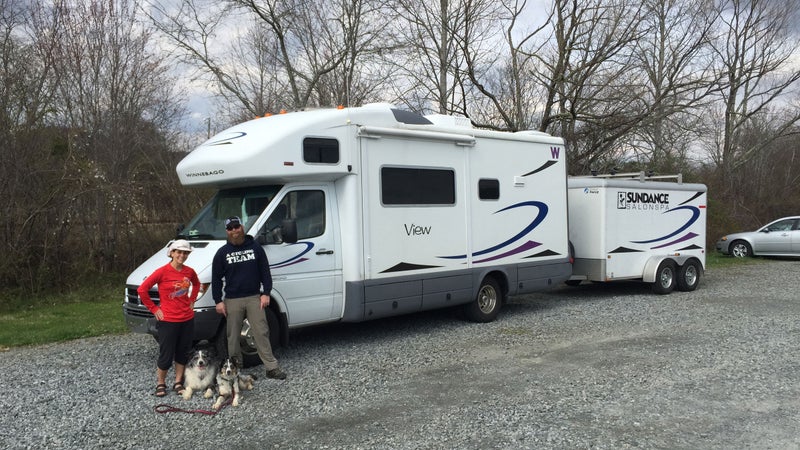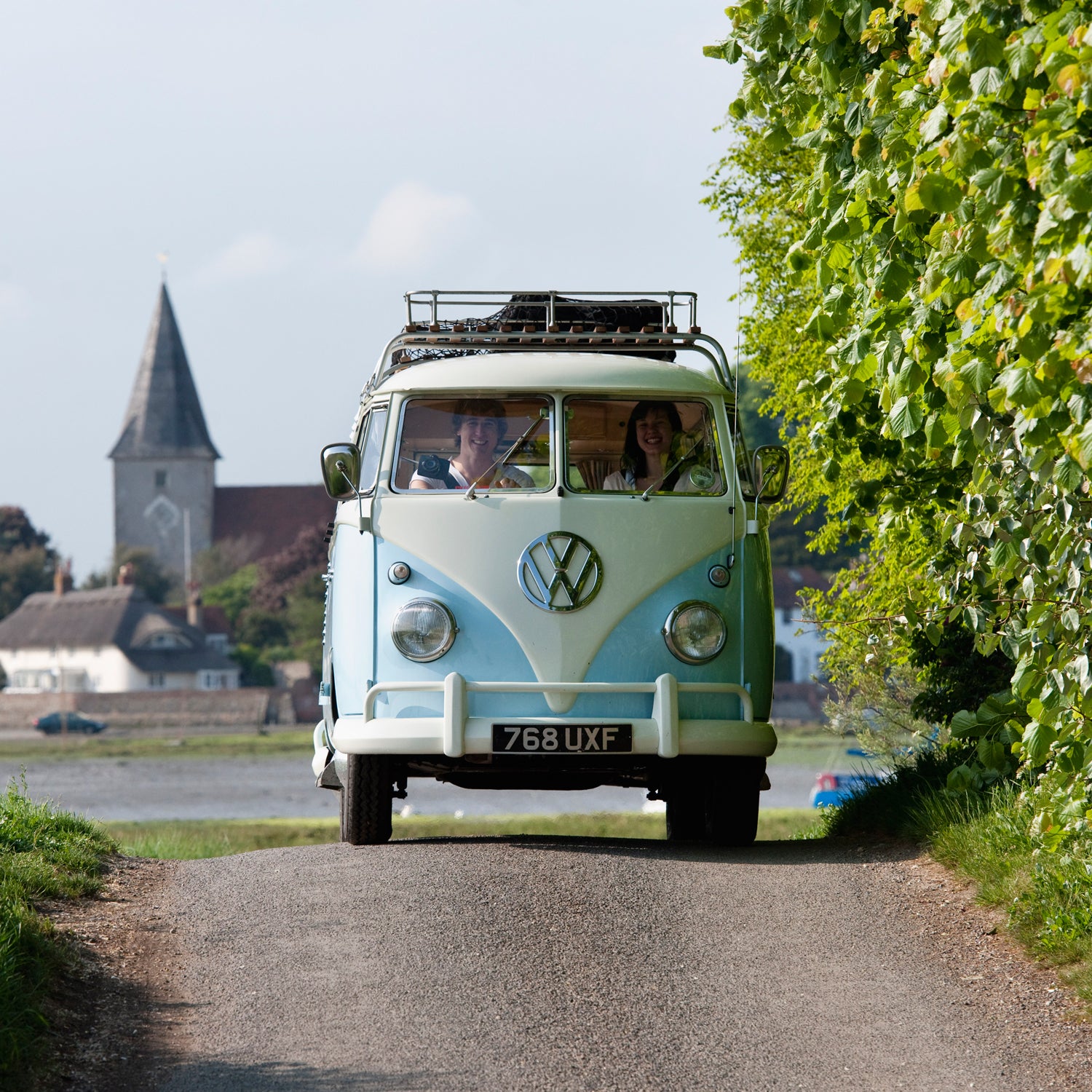It was a simple plan: My friend Sally and I would pilot her Winnebego View down I-65 from Indianapolis to Alabama for five days of awesome mountain bike riding and tasty local microbrew. Our only two traveling companions would be Sally’s Australian shepherds, Charley and Sadie. In good conscience, I couldn’t let Sally do all the driving, so I knew at some point I would have to take the wheel.
But there was a Winnebago-sized problem: I’d never driven a motorhome before, and the idea made me more nauseous than a Guy Fieri cooking show. Her assurances that driving a 23-foot RV was as easy as riding a bike failed to calm my nerves, given how often I crash my Giant Anthem.
Making matters even more difficult, this diesel behemoth had a ten-foot tail: a trailer filled with enough bikes, gear, and tools to open up a small shop. The extra weight made each incline a virtual crawl.
Sally drove for the first hour, imparting nuggets of wisdom she’d learned over 90,000-plus miles behind the wheel: Stay relaxed, don’t make huge overcorrections, and keep your eyes well up the road. We were traveling down wide-open interstate highway, so I wouldn’t need to worry about narrow, twisty country roads—at least, not yet.
Sally’s shown a lot of faith in me over the years but never as much as when she pulled into the rest area and asked, “Do you think you’re ready to drive?”
After spending an inordinate amount of time arranging the mirrors, it was time to hit the road. I half expected the steering wheel to be heavier, befitting the ’s five-ton weight, but it felt more like driving a bulky SUV. With the trailer in tow, I pulled into the fast-moving highway traffic. I felt sick and exhilarated at the same time.
The real, hands-on lessons would now begin. Here are eight things every first-timer should know before their first time on the road with an adventure vehicle.

Rule #1: Don’t Be the Meat in an 18-Wheeler Sandwich
After only 15 minutes behind the wheel, I had the motorhome rolling at a whisper above 65 mph. Despite the relatively slow speed, I still managed to overtake a Walmart semi sputtering along in the right lane. Pulling into the middle lane of the three-lane interstate, I felt the wind shear from the 18-wheeler shake the RV. Then, with almost no warning, a second tractor-trailer appeared, passing on our left. Caught between the two opposing air forces, the Winnebago ping-ponged back and forth as I nervously held onto the wheel for dear life. “So this is how it ends,” I thought to myself. The entire experience took maybe five seconds, but as I tensely gripped the steering wheel, it felt like it would never end.
Which made me realize: RVs are so tall that they are, in essence, a massive metal sail. If it’s really windy, even if far away from the semis, you’ll be fighting gusts the entire time. Better to stay put and let the weather die down.
Rule #2: Use the Right Map
After spending an awesome day in Alabama’s Oak Mountain State Park, Sally and I decided to drive an additional five hours to Pisgah National Forest in Brevard, North Carolina, where some friends were already camped out and enjoying the incredible singletrack.
Finally, we were off the highway and onto narrow county roads. “That sign warned trucks about going up this road—tight switchbacks and no shoulder,” I said. “Should we find another route?”
“I think we’ll be alright,” Sally said. I was skeptical, but she’s piloted this vehicle across the country multiple times.
Over the next hour, the motorhome struggled up one steep, narrow mountain pass after another. In the course of 60 minutes, we traveled just over 15 miles.
A little later, Sally casually mentioned that we could have avoided that hour of terror had we used her specifically for large vehicles, or an specifically made for RVs, instead of my iPhone’s Google Maps app. Using these will not only guide you to the nearest truck stop or RV park but also route you around low-hanging bridges and other obstacles that could either damage your vehicle or cause a massive delay. You can bet we used it on the rest of the way.
Rule #3: Stopping Is More Like Slowing Down
Keeping at least a two-second gap between your vehicle and the one in front of you? Better make it ten. There’s no such thing as a sudden stop in an RV.
Rule #4: Go Wide and Slow… No, Wider and Slower
It’s a blast railing turns in a sports car or on a Trek Remedy, but forget it when you’re behind the wheel of a top-heavy RV. Think you’re turning wide enough? Go even wider, or else you might narrowly miss sideswiping a gas station light pole with your trailer. (Yes, I am speaking from experience.)
Likewise, the slower you can take a turn, the better. Those speed limit signs posted on the curved highway interchanges that you always ignore? You’ll realize why those signs are in place when you take a turn too hot and feel the gravity shift in the RV.
Rule #5: Keep It Tidy
Which brings us to the next rule. Clutter in an RV should be kept minimal; there’s a reason motorhome travel isn’t for packrats. Keep extraneous items stored away in latched cabinets or things could go flying at the first sharp turn. In Sally’s motorhome, the only seemingly nonfunctional item is a Lego RV on the passenger-side dash, but even that serves a purpose.
“If it tips over, you’re driving too fast,” Sally said, even if there was absolutely no chance of that happening over the weekend, at least with me at the wheel.
Rule #6: Plan Ahead for Parking
Have a plan for parking. While at Oak Mountain, we wanted to hit a Birmingham brewery, but after calling ahead, we weren’t sure we could find a spot big enough for the RV. So we went somewhere else.
If you want true mobility, especially in urban areas, consider a camper van or a detachable travel trailer. Or better yet, find the right campsite. In Brevard, you can reach almost everything by bike or hike. A bike trail running through Davidson Campground in Pisgah can take you directly to the nearby Oskar Blues Brewery.
When parking the motorhome, look for level ground—the refrigerator won’t run properly if it’s on an angle, not to mention your pan of eggs could slide off the stove in the morning. If you’re staying at a campground, request a pull-through site. Unless you’re a 4'11″ spitfire who wants to show off her mad reversing skills, why bother with the aggravation of backing into a spot?
Rule #7: Keep Your Hands Clean While Doing the Dirtiest Job
No sales brochure has ever advertised the glamour of emptying the RV’s crapper. As we headed toward the campground exit on the last day of the trip, I knew we were making a pit stop at the (appropriately named) dumping station.
The process of piping poop down the dumping tank is relatively straightforward, but as in all cases with excrement, shit happens—know that every square inch of that dumping station has been sprayed with feces at some point. Use surgical gloves at all times. Try not to breathe in the fumes from the dumping tank when you open the hatch; it was all I could do not to retch right there.
Rule #8: Have Fun
I envisioned frightened retirees scrambling to pack up their gear when they saw the bearded, tattooed hipster pulling into the spot next to them. That couldn’t have been further from the truth. Our neighbors were super friendly, asking advice from Sally and sharing their own tips from their travels.
In fact, everyone we came into contact with—park personnel, other campers, riders on the trail—were incredibly happy, bordering on euphoric. And why not? After a brutal winter, we were outside, surrounded by nature and doing what we loved. I’m already looking forward to our next trip.


